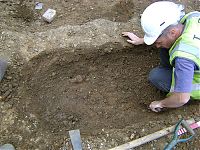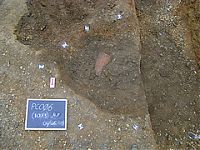Supervisor's report for Friday 6th June
- By: Ashley Pooley |
- Jun 11, 2008
- Share
- del.icio.us

Friday was a fairly hectic day, which saw us having to finish the southern part of Zone 2. This is now occupied by a road giving access to Zone 1 for the plant required to install the piling for that area. Due to the construction schedule, this necessitated the southern area of Zone 2 being completed by the end of Friday.
Various Roman features, chiefly graves, were encountered. Unfortunately the preservation of skeletal material was very poor in this area, mainly due to the ground conditions; the natural sands and gravels into which our graves have been dug, are both very acidic and freely draining. This makes excavating the bodies more difficult than if they had been well preserved both because of their inherent fragility and the poor visibility of the bones against the background sediments.
Three inhumations were dealt with, excavated by Tom, Lukasz, Liz and Gary. Whilst Tom’s, Liz’s and Lukasz’s bodies were buried on an east-west alignment, Gary’s was buried northwest to southeast. Tom’s Context: 1071 was too fragmentary to be able to tell much about the arrangement of the body. Lukasz’s Context: 1032 was buried with the head to the east and with a vessel just to the north of its right foot. Liz’s Context: 1006 was buried with the head to the west whilst Gary’s Context: 1039 was laid out with the head to the southeast . There are probably very significant reasons for this position of the bodies although unfortunately these are now unknown to us and probably reflect a nexus of practice and belief originating from different sources and motivations (for example regional, ethnic, familial, cultic, and wider societal actions imposed upon the individual, to name the more obviously imaginable.) It is salutary to note that we have no real insight into the reasons behind the change from cremation to inhumation around the third century in the western Roman empire. (See Roman Burial practises in Londinium)
And this being archaeology, Fergal surprised us horribly by discovering a last minute additional Roman inhumation Context: 1083 aligned from east to west with its head towards the west supported on a tegula. This kept Greg, Lorna and I on site until about 5.15 while the rest of the team went to the pub and indulged in a spot of speed-drinking. By the end of the evening our brains were as empty as those dry hollow skulls we had left behind just a few hours ago.
See the photo diary for the 6th June for further elucidation.

